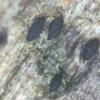
17-12-2025 18:35
 Michel Hairaud
Michel Hairaud
Bonjour à tous/Hi to everyone I am passing along

15-12-2025 15:48
 Danny Newman
Danny Newman
Melanospora cf. lagenaria on old, rotting, fallen

15-12-2025 15:54
 Johan Boonefaes
Johan Boonefaes
Unknown anamorph found on the ground in coastal sa

15-12-2025 21:11
 Hardware Tony
Hardware Tony
Small clavate hairs, negative croziers and IKI bb

15-12-2025 07:09
 Danny Newman
Danny Newman
indet. Rutstroemiaceae sp. on unk. fallen leavesMc

15-12-2025 07:05
 Danny Newman
Danny Newman
Pseudosclerococcum golindoi (det: Zotto)near Cosb

15-12-2025 11:49
 Danny Newman
Danny Newman
ITS sequences from the following two collections B

15-12-2025 12:34
 Danny Newman
Danny Newman
indet. Rhytismataceae on oak leafnear Purchase Roa
I have unsuccessfully tried to determine with the key Key to hysterioid fungi on bark and wood in Scandinavia, AGARICA vol. 42 103.
substrate: Picea, rotten wood, pretty much brittle, on bark
Fruiting body / habit / growth form: immersed, black, like a little mussle
Spores 1: 31.2 - 40.6 x 8.5 - 10.2 µm - Q: 3.55 - 4.10 (Ø LxB: 34.8 x 9.2 ØQ:3.8 N: 9)
Spores 2: 31.6 - 37.9 x 8.4 - 10.2 µm - Q: 3.31 - 4.32 (Ø LxB: 34.3 x 9.3 ØQ:3.7 N: 9)
Spore characteristics: 7-9fach septated, ends on old spores sometimes a little bit brighter
Ascus: biseriat
Paraphyses: filamentous
Spores : brown
Congo red: negativ
Melzers reagent: IKI-
https://fungi.myspecies.info/all-fungi/oedohysterium-insidens
according to Zogg (1962) and other authors the spores don't match perfectly but come close. they are brown and the number of cells fits.
Best regards from Bavaria
Till
I'm having trouble seeing if the ascomata are hysterioid-shaped or mytilinidioid-shpaed.
From what I can see it would be more like mytilinidioid.
A vertical section would be useful.
Thus your fungus grows on Picea. And at last, ascospores don't match. I join a paper to compare with the true Oedhysterium insidens.
I think your fungus belongs to Mytilinidiaceae.
And as I'm preparing a thesis on the subject, I'd be very happy to study it.
If you'd be willing to send me as much material as you can, here's my address:
Alain GARDIENNET
14 rue roulette
21260 VERONNES (France)
If you want you can contact me at : agardiennet@gmail.com. It's a very interesting find
I wonder if it could be a lophiostomataceous fungus, maybe something around Lophiostoma macrostomoides. A vertical section of the ascomata would indeed help, as you said, Alain. But soon we will know more!
Best wishes,
Gernot
Thanks,Alain
PS : Verpa bohemica is already there, Morchella deliciosa perhaps, I will check this afternoon. Morels or mussels , that's a question :)



 Oedohysterium-insidens-0001.pdf
Oedohysterium-insidens-0001.pdf